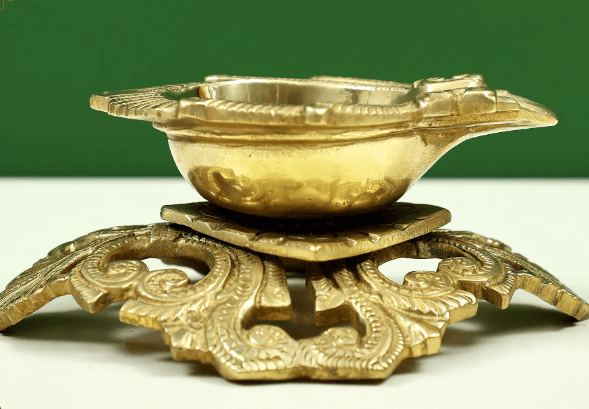Brass Diyas: A Symbol of Light, Tradition, and Spirituality

For thousands of years, brass diyas, the traditional oil lamps of India, have been a feature of religious and cultural activities.These lamps are not just objects of light but are deeply ingrained in Indian spiritual practices, representing purity, prosperity, and the dispelling of darkness both physically and metaphorically.
The diya holds a special place in Indian households and temples, particularly during festivals like Diwali, symbolizing the victory of good over evil, knowledge over ignorance, and hope over despair.
In this comprehensive article, we will explore the historical significance, cultural importance, types, and benefits of using brass diyas, along with a step-by-step guide on how to use them in daily life and special occasions.
Introduction to Brass Diyas
A brass diya is a type of traditional oil lamp used widely in Indian culture, especially in Hinduism, Buddhism, and Jainism. These lamps are typically made from brass, an alloy of copper and zinc, which is known for its durability and aesthetic appeal. Brass diyas are often lit during prayers, religious rituals, festivals, and special occasions, symbolizing the presence of divine light. Unlike modern electric lamps, brass diyas rely on natural fuels like oil or ghee and cotton wicks to produce light.
The diya’s form and structure are simple yet elegant. It usually consists of a shallow bowl to hold oil or ghee, with a wick extending out of the bowl to provide light when lit. The lamp’s glow is associated with positive energy and spiritual purification, making it an essential element in any Indian household or temple.
See also: The Crucial Role Of A Transfer Agent In Securities Markets
Historical Significance of Diyas
The origin of diyas dates back to ancient India, where they were used as a primary source of light in homes and temples long before the advent of electricity. In Hindu scriptures like the Vedas and Puranas, the concept of lighting a lamp is seen as a gesture of devotion to deities, a practice that continues to this day.
One of the world’s oldest known scriptures, the Rig Veda, is where the significance of lighting diyas may be found.The Atharva Veda also mentions the use of lamps as a medium to invoke divine presence. Brass diyas were valued not just for their functionality but for their symbolic importance in spiritual practices.
During the Gupta Empire (320-550 CE), diyas became more ornate and began to hold cultural and religious value in royal courts and temples. The artistic designs of diyas evolved, incorporating images of gods and goddesses, intricate carvings, and varying sizes to suit different rituals.
Symbolism of Light in Indian Culture
Light is considerably more than just a source of illumination in Indian philosophy; it also stands for the divine, purity, and wisdom.The act of lighting a diya during prayers and festivals is considered an offering of one’s devotion to the gods and a means of seeking their blessings.
- Victory of Good Over Evil: Lighting a brass diya signifies the triumph of good over evil, as celebrated during the festival of Diwali, when Lord Rama returned to Ayodhya after defeating the demon king Ravana.
- Dispelling Darkness: In both a literal and spiritual sense, light dispels darkness. Lighting a diya symbolizes the removal of ignorance, greed, and negative emotions, bringing wisdom, peace, and joy.
- Spiritual Awakening: In Hinduism, light is associated with Agni, the fire god. The flame of the diya represents the soul’s aspiration to connect with the divine and gain spiritual knowledge. It is also considered an embodiment of Shakti, or cosmic energy, that permeates the universe.
Types of Brass Diyas
Each brass diya serves a particular purpose and appeals to a diverse set of people in terms of size, shape, and design.Below are some of the most common types of brass diyas used in Indian households and temples:
Traditional Single-Wick Diya
This is the most basic and commonly used brass diya, featuring a single wick. It is often used in everyday prayers and small rituals. Its simple design makes it easy to handle and maintain.
Multi-Wick Diya (Pancha Deepam)
A multi-wick diya, also known as Pancha Deepam, typically holds five or more wicks. This type of diya is used for larger ceremonies and in temples. The multiple flames are said to invoke multiple deities at once, bringing prosperity and positive energy.
Hanging Brass Diya
These diyas are designed to be hung from ceilings or hooks, adding a decorative and sacred element to any space. They are often used in temples and larger homes for lighting courtyards or worship areas.
Peacock Brass Diya
Peacock designs are considered auspicious in Indian culture, symbolizing grace and beauty. Brass diyas featuring intricate peacock designs are often used for special occasions and rituals, adding an element of elegance.
Brass Kamakshi Diya
This diya is named after the goddess Kamakshi and is often used in South Indian households for pujas (prayers). It has a wide base and is highly decorative, with engravings of the goddess or other symbolic patterns.
The Benefits of Using Brass Diyas
Brass diya offer various benefits, both spiritual and practical, that make them a staple in many Indian homes:
- Spiritual Purification: Lighting a diya is believed to purify the surroundings by driving away negative energies and filling the space with positive vibrations.
- Durability: Brass is a long-lasting material that doesn’t rust easily, making brass diyas highly durable. They can be passed down through generations as family heirlooms.
- Health Benefits: Lighting a brass diya filled with ghee or natural oils produces a calm, steady flame, which is believed to have therapeutic benefits. The gentle flicker of the flame can reduce stress and promote mental clarity.
- Eco-Friendly: Unlike modern electric lamps, brass diyas rely on natural resources like oil and ghee, making them an environmentally friendly option.
Step-by-Step Guide to Using Brass Diyas
Using a brass diya is simple, but certain practices can enhance its spiritual and aesthetic impact. Here’s how to properly use a brass diya:
- Preparation: Before using the diya, clean it with water and mild soap. Some people polish the diya with lemon juice or vinegar to maintain its shine.
- Filling the Diya: Pour a small amount of oil (mustard oil or sesame oil) or ghee into the diya. The amount should be enough to keep the wick burning for the desired duration.
- Inserting the Wick: Use a cotton wick and place it into the diya so that one end is submerged in the oil while the other end sticks out. The exposed end should be at a slight angle for easier lighting.
- Lighting the Diya: Using a matchstick or lighter, carefully light the wick. The flame should be steady, and the wick should not produce smoke or flicker excessively.
- Placement: Place the diya on a clean, sacred surface like an altar or a windowsill. If placing the diya outdoors, ensure it’s protected from wind.
- Maintenance: After the oil or ghee has been consumed, clean the diya to remove any residue. Regular maintenance ensures the diya remains in good condition and continues to emit a clean flame.
Brass Diya in Festivals and Religious Ceremonies
Diwali
Diwali, the Festival of Lights, is the most prominent occasion when brass diyas are used. Homes are illuminated with rows of diyas to celebrate the return of Lord Rama to Ayodhya and to symbolize the victory of light over darkness.
Navratri
During the nine days of Navratri, diyas are kept lit continuously in front of deities, especially in temples dedicated to Goddess Durga. This practice signifies the undying devotion and focus on spiritual growth.
Weddings and Special Occasions
Brass diyas are also part of wedding rituals, where they are used to seek blessings from the gods for a prosperous and happy married life. The lighting of a diya marks the start of auspicious ceremonies.
Maintenance and Care of Brass Diyas
Brass, though durable, can tarnish over time. To maintain the shine and appearance of your brass diya, follow these steps:
- Regular Cleaning: Clean the diya after every use with warm water and mild detergent. Avoid using harsh chemicals that may corrode the brass.
- Polishing: Brass tends to develop a dull patina. Polishing with natural ingredients like lemon and baking soda can restore its luster.
- Storage: When not in use, store your brass diya in a dry, cool place to prevent tarnishing. Wrapping it in a cloth can also protect it from dust and oxidation.
Environmental and Health Benefits of Brass Diyas
Brass diyas offer several environmental and health benefits:
- Eco-Friendly: Since brass diyas are made from natural materials and use sustainable fuels like ghee or oil, they have a lower carbon footprint than electric lights.
- Natural Light Therapy: The steady flame of a brass diya, especially when ghee is used, emits light that is believed to have calming effects on the mind and body. It can reduce stress, improve focus, and promote a peaceful atmosphere.
Conclusion: The Eternal Flame of Brass Diyas
Brass diyas are more than just decorative items or traditional lamps; they are bearers of light, hope, and spiritual wisdom. Their timeless beauty and deep-rooted significance in Indian culture make them an essential part of religious and social rituals. Whether used for daily prayers or grand festivals, the diya serves as a reminder of the importance of light in our lives – both as a source of illumination and as a symbol of the divine presence that guides us through life’s challenges.
By incorporating brass diyas into your daily rituals, you not only honor ancient traditions but also bring a sense of peace, purity, and positivity into your home. The glow of a diya, like the wisdom it represents, is eternal.




